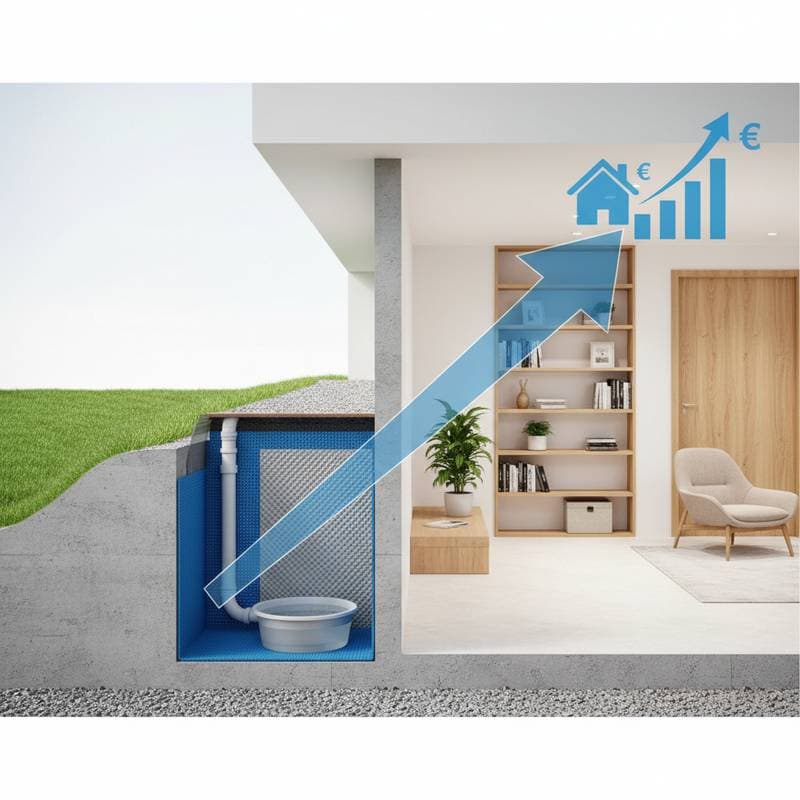Understanding Basement Waterproofing Essentials
Homeowners often overlook basements until water issues arise. These spaces serve as vital foundations for living areas, storage, and utilities. Effective waterproofing protects against infiltration from groundwater, heavy rains, and poor drainage, preserving the entire structure over decades.
In 2025, advanced materials and techniques make installation more accessible. Systems integrate seamlessly with existing homes, addressing vulnerabilities without major disruptions. Early intervention prevents escalation of problems like mold growth and foundation cracks.
Consider a typical scenario: a mid-sized home in a rainy region faces seasonal flooding. Without protection, repair costs accumulate rapidly. Waterproofing shifts this dynamic toward proactive ownership.
Key Costs and Investment Breakdown
Initial expenses for basement waterproofing vary by home size, location, and method. Interior solutions, such as sealants and sump pumps, range from $2,000 to $10,000 for a 1,000-square-foot area. Exterior approaches, involving excavation and membrane application, typically cost $10,000 to $30,000 or more.
Factor in regional differences. Coastal areas with high humidity demand robust barriers, increasing prices by 20 percent. Inland properties might suffice with simpler drainage upgrades.
Long-term savings offset these outlays. Energy bills drop as insulated, dry basements retain heat better. Professional assessments, often free from contractors, help pinpoint exact needs and budget accordingly.
Calculating Return on Investment Over 25 Years
ROI for basement waterproofing emerges from multiple angles. Prevented damage alone can recoup costs within five years. For instance, untreated leaks lead to $5,000 annual repairs; sealed systems eliminate this burden.
Home value appreciation adds significant returns. Properties with certified waterproofing sell 10 to 15 percent higher, according to market analyses. Over 25 years, this translates to $50,000 or more in equity gains for an average home.
Energy efficiency contributes further. Dry basements reduce HVAC strain, yielding 15 to 20 percent lower utility costs yearly. Compound these savings: a $200 monthly reduction over decades exceeds the original investment.
Use this simple formula for personal calculation: (Prevented Costs + Value Increase + Energy Savings) divided by Initial Outlay, multiplied by 100 for percentage ROI. Tools from home improvement sites assist in precise projections.
Selecting the Right Waterproofing Solutions
Multiple options suit different needs and budgets. Interior drainage systems channel water to pumps, ideal for finished basements. These involve installing perimeter pipes and vapor barriers, completed in a weekend.
Exterior waterproofing provides comprehensive defense. Digging around the foundation allows for sealant application and grading improvements. This method excels in severe climates but requires permits and landscaping restoration.
Hybrid approaches combine both for optimal results. Smart sensors monitor moisture levels, alerting owners to issues early. Choose certified products from reputable brands to ensure 25-year durability warranties.
Consult local experts for soil type evaluations. Clay-heavy soils retain water, necessitating deeper French drains. Sandy grounds drain quickly, suiting surface-level solutions.
Adapting to Climate and Regional Challenges
Climate influences waterproofing strategies profoundly. In humid southern states, prioritize dehumidification integrated with sealing. These setups control condensation, preventing wood rot in crawl spaces.
Northern regions with freeze-thaw cycles demand frost-resistant materials. Insulated membranes prevent cracking from expansion. Install during dry seasons to avoid complications.
Urban versus rural settings also matter. City homes benefit from municipal drainage ties, reducing individual system loads. Rural properties often require standalone pumps with battery backups for power outages.
Sustainability trends in 2025 favor eco-friendly options. Permeable coatings and recycled membranes lower environmental impact while maintaining efficacy. Governments offer rebates for green upgrades, enhancing ROI.
Maximizing Long-Term Protection and Benefits
Routine maintenance sustains waterproofing effectiveness. Annual inspections check seals and pumps, costing under $200. Address minor issues promptly to avoid cascading failures.
Integrate with broader home upgrades. Pair waterproofing with energy audits for compounded efficiency. Finished basements become usable living spaces, boosting daily comfort and resale potential.
Over 25 years, these investments yield peace of mind. Families enjoy dry, safe environments without surprise expenses. Properties stand resilient against worsening weather patterns driven by climate change.
Securing Your Home's Enduring Value
Basement waterproofing transforms potential liabilities into assets. It delivers measurable financial returns through damage avoidance, value enhancement, and operational savings. Homeowners who act now position themselves for decades of stability.
Evaluate your property's risks today. Professional guidance tailors solutions to specific conditions, ensuring optimal outcomes. This step safeguards not just structures, but legacies of security and prosperity.



